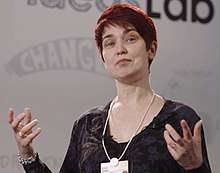Mary Ryan (engineer)
Mary P. Ryan FREng is a Professor of Materials Science at Imperial College London and a Fellow of the Royal Academy of Engineering.
Mary Ryan | |
|---|---|
 Ryan speaks at the World Economic Forum in 2016 | |
| Born | Mary P. Ryan |
| Alma mater | University of Manchester |
| Known for | Nanoscience Corrosion |
| Scientific career | |
| Institutions | Imperial College London Brookhaven National Laboratory |
| Doctoral students | Eleanor Schofield[1] |
| Website | imperial |
Education
Ryan completed her undergraduate and postgraduate studies at the University of Manchester.[2] Her PhD was on using "in-situ ECSTM to study the formation of ultra-thin surface oxides on base metals", and she managed to show for the first time that these surface oxides have crystalline phases.[3][4] She spent three years at Brookhaven National Laboratory, New York, where she developed in situ electrochemical systems using synchrotron radiation-based techniques.[3][5]
Career and research
Ryan is an expert in electrochemistry and interfacial material science.[6] Ryan joined Imperial College London as a lecturer in 1998.[2] Her research group explore the mechanism of corrosion, new protective materials and materials with thermal management capabilities.[2] She studies the process of electrochemical deposition, the stabilities of metals and the formation processes of metal and oxide nanostructures.[7] She pioneered the use of synchrotron X-rays to study reactive electrochemical systems, including the stability of nanostructures.[8] In 2002 she published the seminal paper "Why stainless steel corrodes" in Nature.[9] In 2012 she joined Amy Cruickshank to advise on how to preserve the Dornier Do 17 ('The Flying Pencil'), which was discovered in Goodwin Sands.[10] She also contributed to the 2016 World Economic Forum, where she discussed how nano-composite materials could use heat from a vehicle's engine to power air conditioning.[11]
Her recent work focusses on how nanomaterials interact with biological systems, including the toxicity of nanoparticles and development of plasmonic materials for biosensing.[12] She works with the heritage sector to develop new materials and conservation techniques.[12] She has worked with the Science Museum, the Royal Air Force Museum London and the Victoria and Albert Museum.[13] She collaborates extensively with Dr Eleanor Schofield, Head of Conservation and Collections Care at the Mary Rose Trust.[12][14][15]
In 2017 she was appointed Vice Dean of Research for the Faculty of Engineering at Imperial College London.[16] She is the Director of the Imperial-Shell University Technology Centre in Advanced Interfacial Materials Science.[17] Ryan is a member of the London Centre for Nanotechnology.[18] She is an editor for Nature's Materials Degradation Journal.[8] She was elected a Fellow of the Royal Academy of Engineering in 2015.[6] She is a Fellow of the Institute of Materials, Minerals and Mining. She is a member of the Strategic Advisory Network of the Engineering and Physical Sciences Research Council.[19] She is a Trustee of the Heritage science forum.[20]
References
- Schofield, Eleanor Josephine (2006). Formation and characterisation of nanoporous materials. jisc.ac.uk (PhD thesis). Imperial College London (University of London). OCLC 500283573. EThOS uk.bl.ethos.429052. Archived from the original on 9 December 2018. Retrieved 7 December 2018.
- "Prof Mary Ryan - Imperial Tech Foresight". www.imperialtechforesight.com. Retrieved 7 April 2018.
- "Invited Speakers". RAMS 2015. 29 January 2015. Retrieved 7 April 2018.
- "Mary Ryan". World Economic Forum. Retrieved 7 April 2018.
- Ryan, M. P.; Laycock, N. J.; Isaacs, H. S.; Newman, R. C. (1 January 1999). "Corrosion Pits in Thin Films of Stainless Steel". Journal of the Electrochemical Society. 146 (1): 91–97. doi:10.1149/1.1391569. ISSN 0013-4651.
- "New Fellows - Mary Ryan". Royal Academy of Engineering. Retrieved 7 April 2018.
- "Annual Invited Lectures | Icon". icon.org.uk. Retrieved 7 April 2018.
- "About the Editors | npj Materials Degradation". www.nature.com. Retrieved 7 April 2018.
- Ryan, Mary P.; Williams, David E.; Chater, Richard J.; Hutton, Bernie M.; McPhail, David S. (2002). "Why stainless steel corrodes". Nature. 415 (6873): 770–774. Bibcode:2002Natur.415..770R. doi:10.1038/415770a. ISSN 1476-4687. PMID 11845203.
- "Big Ask | Mary Ryan tries to save the last Flying Pencil". www.labnews.co.uk. Retrieved 7 April 2018.
- World Economic Forum (19 February 2016), Holistic heat management | Mary Ryan, retrieved 7 April 2018
- "Research - Professor Mary Ryan". www.imperial.ac.uk. Retrieved 7 April 2018.
- "Icon Heritage Science Group: Annual Invited Lecture by Prof Mary Ryan". icon.org.uk. Retrieved 7 April 2018.
- "Lab Profile: Dr Eleanor Schofield - Materials Today". Materials Today. Retrieved 7 April 2018.
- "Conserving Britain's most precious antique ship | Imperial News | Imperial College London". Imperial News. Retrieved 7 April 2018.
- "VICE-DEANS, FACULTY OF ENGINEERING" (PDF). Imperial College London. 31 May 2017. Retrieved 7 April 2018.
- "Shell-Imperial Advanced Interfacial Materials Science (AIMS) Centre". Imperial College London. Retrieved 7 April 2018.
- "Mary Ryan | London Centre for Nanotechnology". www.london-nano.com. Retrieved 7 April 2018.
- "People - EPSRC website". epsrc.ukri.org. Retrieved 7 April 2018.
- "Trustees | National Heritage Science Forum". www.heritagescienceforum.org.uk. Retrieved 7 April 2018.